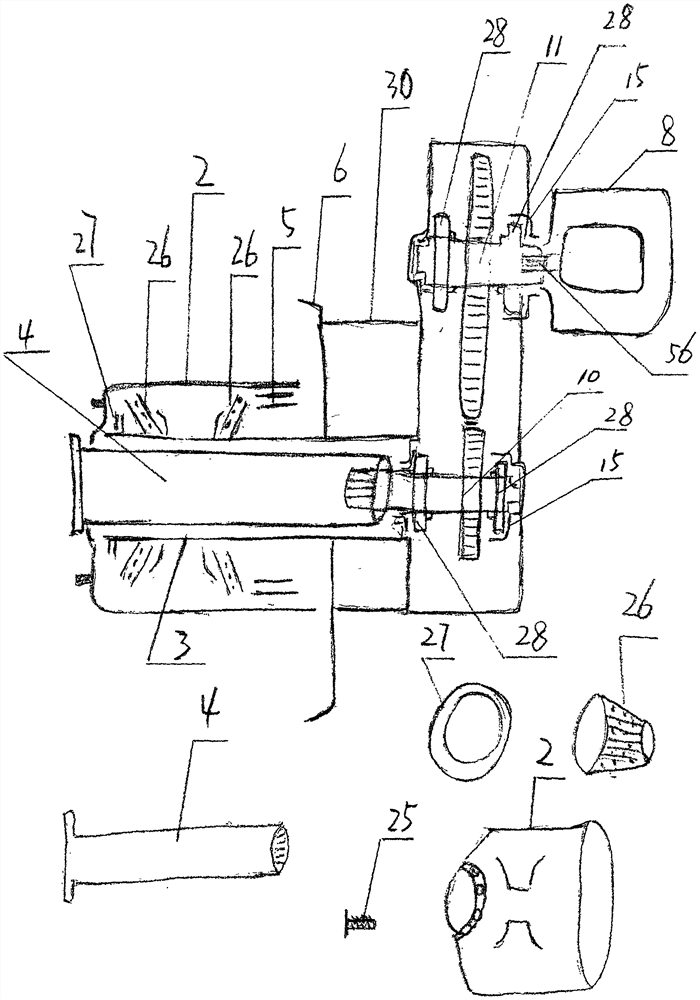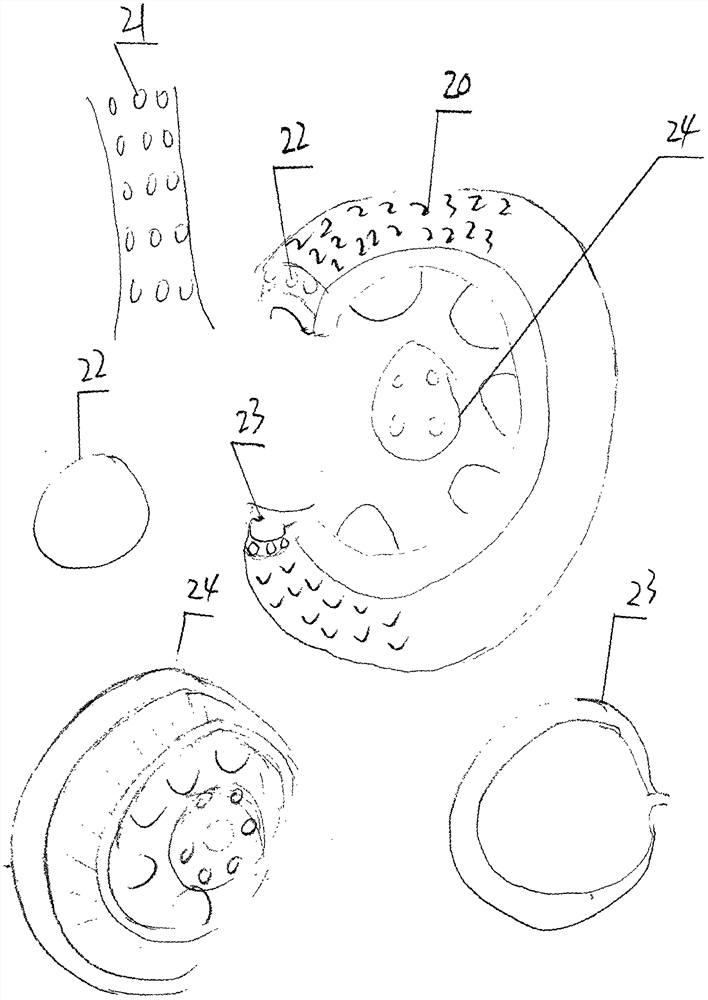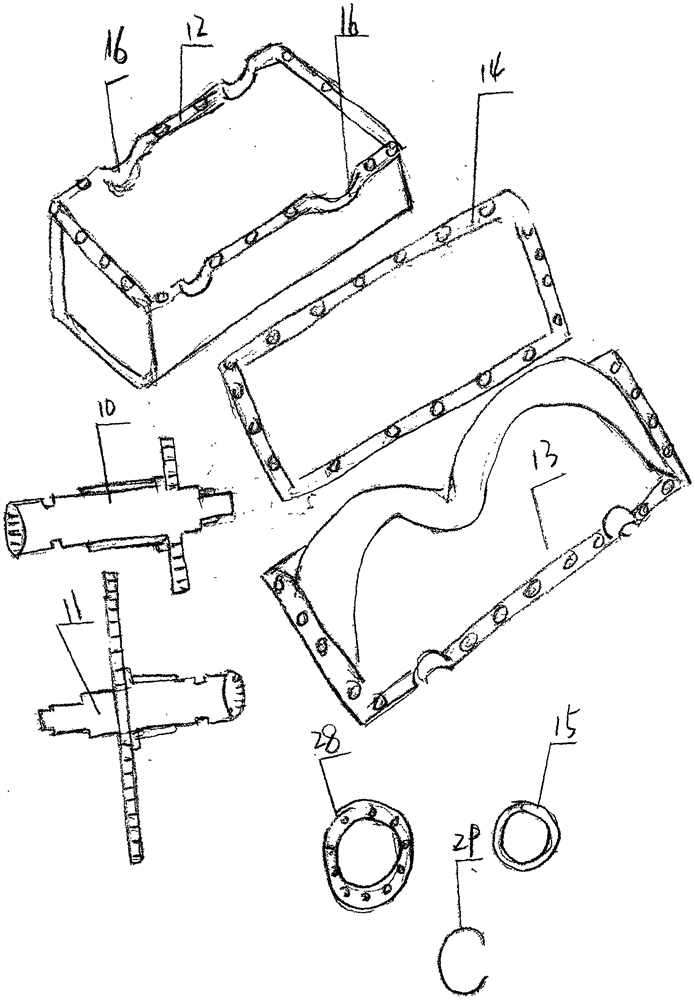[0002] In the prior art, the actual
utilization rate of energy during driving is only about 60%, and the reasons for the
energy loss mainly include the following aspects: 1. All vehicles running on the road must be equipped with high power equipment , this is the special demand for the
power output of the vehicle, such as the vehicle load and road conditions, and the instantaneous acceleration performance under special circumstances when the vehicle is running. All vehicles must be equipped with power equipment that is much larger than the power required for stable driving, but when the vehicle completes the start and enters stable driving, the power of the matched power equipment is far greater than the required power. In this case, it will inevitably increase. The reactive
power loss of the vehicle's power equipment has caused the reactive power waste of energy during the vehicle's driving. However, if it does not match the power equipment that is larger than the normal driving of the vehicle, it cannot normally achieve climbing and starting and driving in complex road conditions. At the same time, when When the power equipment and the vehicle have not yet formed a certain rotational
potential energy, the starting and low-speed driving of the vehicle consume more energy. Under normal circumstances, the time for the vehicle to start or
climb a slope is generally shorter, while normal and stable driving But the time is very long, so for a very short time to start or
climb a slope and equipped with super-power power equipment will inevitably lead to waste of
energy consumption; In other words, including the fuel energy used by the
internal combustion engine and the
electric energy used by the
electric motor, most of the energy is lost due to friction and
heat generation during the conversion of
mechanical energy, especially the
energy loss of the
internal combustion engine is particularly large, which includes heat dissipation from the cooling
system and
exhaust gas.
Energy loss caused by
system heat dissipation and frictional heat generated during braking, energy loss caused by inexhaustible fuel
combustion, and energy loss caused by frictional heat generated by various rotating parts in the transmission and transmission mechanism
3. Various resistances during
vehicle driving have a certain
impact on energy loss; including the shape of the vehicle body, the
friction coefficient of the road, and the out-of-roundness of the tires, etc. will all lead to energy loss, and the wind resistance caused by different vehicle body streamlines The energy loss of the vehicle is different. The good flow
linearity of the vehicle body makes the resistance of the vehicle relatively small during driving, and the energy loss is relatively small. The driving resistance of the vehicle body with poor flow
linearity is relatively large, resulting in relatively large energy loss. Ice and
snow or slippery roads cause the wheels to skid and generate heat, resulting in energy loss, and the wheels are out of round due to insufficient inflation of the tires, resulting in increased rotational resistance and increased energy loss, etc. These energy losses lead to the energy efficiency of the car generally being around 40%. , the highest is less than 60%, and the effective
utilization rate of its energy is very low
[0003] The effective utilization rate of energy is closely related to the vehicle technology. The quality of the comprehensive vehicle technology is the key link affecting energy efficiency. Different brands, different manufacturers and different mechanical technologies have different
effective energy utilization rates. Some domestic brand models apply
energy recovery technology to electric or
gasoline-electric
hybrid vehicles, and have obtained certain effects of energy saving and consumption reduction and increased cruising range. These brand models mainly use electric motors to switch generators to generate
electricity for
energy recovery. , Some are called regenerative braking, some are called
energy feedback. The
advantage of this technology is that it has a simple structure. To a certain extent, it reduces the consumption of battery power and increases the cruising range, but this technology also has certain weaknesses. First, the kinetic
energy recovery is intermittent. It only switches to the power generation mode when the vehicle needs to decelerate and starts to recover kinetic energy.
Kinetic energy cannot be recovered when the vehicle’s normal driving kinetic energy is relatively stable, and the
recovery of kinetic energy during deceleration will cause the kinetic energy to drop rapidly with the decrease of vehicle speed, so that the short-term kinetic energy
recovery has little effect; the second is during the conversion process from the motor to the generator Insufficient fusion of the middle
system leads to the magnetic resistance generated instantaneously by the generator excitation, which makes the normal driving vehicle feel dragged and reduces the comfort of the ride; the third is that the resistance generated during power generation slows down the vehicle or stops it, resulting in incomplete kinetic energy
recovery As a result, most of the kinetic energy is wasted in vain. In the normal driving process of the car, according to the complex road conditions, the
traffic conditions when the
urban area is mixed with people and vehicles make the vehicle always stop and go repeatedly during the driving process, sometimes at low speeds, sometimes at low speeds. At high speed, emergency braking will be performed in case of emergency. The driver controls the accelerator pedal and
brake pedal to complete these complicated working conditions. When the driver depresses the
brake pedal according to the need to slow down or stop the vehicle, the When the resistance of the
energy system is lower than the resistance required for braking, or the
absorbed energy has exceeded the upper limit of battery charging or
power consumption of
electrical equipment, this kinetic energy still has to rely on traditional brakes to convert it into useless waste in the form of friction and heat. The
heat energy is lost to the environment, so the kinetic energy recovery has the disadvantages of incomplete conversion and low utilization rate through the simple kinetic energy
recovery method; under the existing technical conditions, we have found the shortcomings of electric vehicles in terms of energy saving and energy recovery, but At the same time, we also know that there are many difficulties faced in the recovery and conversion of kinetic energy. These difficulties are mainly manifested in the characteristics of kinetic energy and the structure and technical means of the vehicle. The difficulties to be faced are mainly manifested in: the kinetic energy of the vehicle during driving The characteristic usually manifests as the
instability and dispersion of the energy size and strength. The dispersion of the kinetic energy of the vehicle during driving is mainly manifested in the fact that any part of the vehicle body will produce a mechanical response no matter it touches anything.
Kinetic energy is composed of the weight and speed of the vehicle body. At the same speed, the greater the
mass of the vehicle body, the greater the kinetic energy will be. The faster the vehicle body
mass will be, the greater the kinetic energy will be. It can be seen that the kinetic energy of the vehicle body is determined by the vehicle body.
Body weight and driving speed, so the kinetic energy spreads throughout the car body and It is decentralized, and it also includes the following technical difficulties in the conversion and utilization of kinetic energy: 1. The kinetic energy formed during the driving of the vehicle has the characteristics that it cannot be preserved; 2. The kinetic energy is a lagging force and cannot be directly used as a driving force. The force acting on the vehicle body is always changed from strong to weak due to various factors such as the environment and air resistance during driving, and the force reflected by the kinetic energy is a lagging force and cannot be directly used as a driving force; 3. Install a generator on the vehicle to generate
electricity To face the problem of
energy conservation, how to overcome the magnetic resistance generated during power generation load; 4. In the vehicle structure and power generation
transmission technology, it is necessary to overcome where to extract the dispersed kinetic energy from the vehicle body, how much kinetic energy should be extracted, and what kind of A series of technical problems, such as the extraction of kinetic energy by the transmission method, how to integrate the kinetic energy of the vehicle with the
power demand of the generator, and how to integrate the
electricity generated by the generator with the battery and
electrical equipment[0004]
Electric energy is the only source of energy for electric vehicles. At present, pure electric vehicles rely entirely on
battery charge and
discharge cycles for power supply. However, the storage space for battery power is limited, so the battery power and
voltage continue to decrease with the increase of mileage. Sometimes the instrument shows that there is still a certain amount of power but Sudden power failure during driving makes electric vehicles unable to drive. At present, the rapid development and large scale of China's
electric vehicle industry are obvious to all the world, and the government and
electric vehicle companies are also trying their best to solve many problems faced by consumers in the use of electric vehicles. , the core problem is to solve the mileage and charging problems of electric vehicles, and companies are also increasing research and development efforts on the mileage of batteries, and increasing
capital investment in supporting charging facilities in residential areas and building charging and swapping services, etc. Measures to improve the deficiencies in the use of electric vehicles, but the construction of state-guided
fast charging stations requires a lot of funds and sites, involving the income and risks of investment entities, because there are many uncertainties in the technology of electric vehicles, including battery technology, and these Factors will directly affect the future development prospects of electric vehicles. A series of uncertainties make investors dare not invest lightly. Secondly, enterprises also face many difficulties in the construction of charging facilities and
power station construction in the
community. First, different types of batteries The requirements for charging facilities are different. If the technical parameters of the charging
pile and the battery do not match, charging the battery will have a certain
impact on the service life of the battery. There is no unified standard for the types of batteries used in electric vehicles and the matching with charging piles. The quality of batteries and charging technology are not perfect, resulting in problems such as too short mileage, too long
waiting time for charging, short battery life and high cost. Firstly, the enterprises building charging facilities in the
community need to comply with the agreement of the property management of the
community or the neighbors of the electric vehicle users; thirdly, enterprises also face many difficulties in building battery swap stations. The difference between the old and the new makes it a headache to replace the
power station. Because electric vehicles are affected by the storage capacity of the battery, the temperature of the battery, the network of charging stations, and the supporting facilities for charging, users will always worry about the
voltage drop of the battery or the exhaustion of the battery when driving. The
anxiety caused by the inability to drive, and many of the above unfavorable factors will directly affect the rapid development of the electric vehicle industry
 Login to View More
Login to View More  Login to View More
Login to View More 


